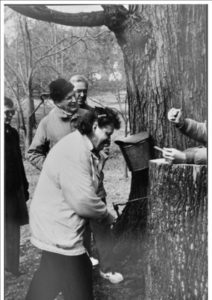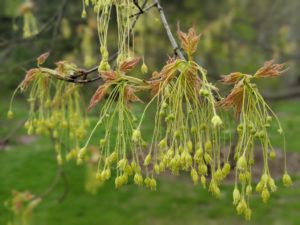Maple trees have special significance in American culture. They provided our own homegrown source of sweetener when honey was unavailable and cane sugar needed to be shipped to the colonies. Today, bottles of maple syrup are in cupboards all across America, used in cakes, put on ice cream and served warm on pancakes and waffles. At Tyler, we’ve gathered together for years at our annual Pancake Breakfast to celebrate the maple syrup making process, community, and the changing seasons by sharing pancakes, coffee and hot chocolate.

The story of maple syrup goes back further than Tyler, and further than America as a nation. The first settlers learned the technique of maple sugaring from the Indigenous communities who have lived alongside the maple trees far longer than we have. The Lenape tell this story of how the people learned to use maple syrup.
The Story of the Maple Tree
Many, many moons ago, one of the most beautiful trees around was the maple. And its roots reached deep into the earth and its branches reached high in the heavens. But at one time, a large group of bugs crawled into the maple’s bark. And it was itching the maple. It was driving the maple tree crazy. Cause even though the maple tree had many branches and shoots and roots, it could not bend down and reach all parts of itself. So it called out to all its friends in the animal kingdom. It called out and said, “Can someone please give me some relief from all this itching?”
So the beaver said, “Well maple tree I can probably do it, but if I start chewing on your bark it’ll probably kill you. So that would not help you that much.”
And then the little mouse said, “Maple tree I can dig down into your roots and get my brothers the voles and the moles and the gophers but we’ll end up starting to kill your roots and that will kill you.”
So then the bear said, “Well maple tree, I have these nice big claws. I could start clawing at your bark but that will probably shred you up.”
So then they are all trying to think. Finally, one of the birds was flying by and it was a flicker. And the flicker said, “Well maple tree I have a cousin. How about I get all these guys to come and their beaks are sharp and they can dig in you, but they won’t hurt you.”
So they called all of his woodpecker friends and they flew over and started pecking at the tree and got all the bugs out of him. The tree was so happy. And everything was going along nicely and all of a sudden for a couple of years, there was very little rain. It got very dry and all of the animals were getting very thirsty. The creeks and rivers had all dried up and they did not know where to go. They were all bemoaning the fact and the maple tree heard them. And the maple tree said, “You know the animals helped me the time I was suffering from all those bugs biting me. I have an idea.”
 So he called to his friend the flicker again and said, “Flicker, you helped me in my time of need. I want to help you. Call up your woodpecker buddies again.” So they call the woodpecker buddies. And the maple tree said, “Now I want you to peck deep into my bark and then wait for a second and soon some of my sap will run out and you can slake your thirst by drinking my sap.” So the woodpeckers tried it. And when they did the sap flowed from the maple tree. And that gift saved everybody until the next rain came and they were able to drink from the creeks again. And it was from that gift, from the maple to the animals, that man learned how to make maple syrup and how to tap those maple trees when the sap runs. Maple syrup was precious because man could make something sweet, especially in the winter time when there were no berries to pick and no sweet things to eat. That was the time when we really appreciated the gift of the maple tree.
So he called to his friend the flicker again and said, “Flicker, you helped me in my time of need. I want to help you. Call up your woodpecker buddies again.” So they call the woodpecker buddies. And the maple tree said, “Now I want you to peck deep into my bark and then wait for a second and soon some of my sap will run out and you can slake your thirst by drinking my sap.” So the woodpeckers tried it. And when they did the sap flowed from the maple tree. And that gift saved everybody until the next rain came and they were able to drink from the creeks again. And it was from that gift, from the maple to the animals, that man learned how to make maple syrup and how to tap those maple trees when the sap runs. Maple syrup was precious because man could make something sweet, especially in the winter time when there were no berries to pick and no sweet things to eat. That was the time when we really appreciated the gift of the maple tree.
Lomewe ahpu ansikemes. Welesu. Wechephìka mexitkweyok hakink ok wetuhona hateyo hukweyunk mushhakunk. Shek kweten xaheli muxwesak pemuxsuwak wehokesemink. Na na ansikemes kshipsun. Nek muxwesak nachihku na ansikemes. Na ansikemes wulhatuna xeli tuhona ok chephika shek tola kwetenemen alente tuhwepi. Na ansikemes pechimaok nek aesesak. Luwe, “Ksi, awèn wichemi. Sakomalsi.”
Na tamakwe luwe, “Ansikemes, kewinkwichemel, shek sheshontamenane khokes konaet knihelel. Ntala kewichemel.”
Ok na pukwestet luwen, “Ansikemes nkaski olhe kechephikank ok newichemkuk nexisemesak nek xapxuweyòk, shek xu nepolitunen kechephikema, ok ktankelch.” Na maxkw luwen, “Ansikemes nulhatuna xinkhwikahsha. Nkaski keshewipxkonenel shek khokes xu pikat.”
Na nteheyo. Xantki ulikwen pe. Ok na ulikwen luwe,
“Ansikemes nulhalaok naxansak. Xu yu tali mpeshuwaok. Kineyok welukonewoo shek xu takuu keshinalkuk.” Pweshewaok wemi witisak ok kenthuwak ansikemesink ok muhkuwoo wemi nek muxwesak. Na hitukw winkhatenamu. Wemi keku welet. Salàxki kahapan ok nek aesesak katusemuwak. Nel sipuwa kaxkteyo ok nek aesesak ku uwatuweneyo tani eyok a. Wemi nel aesesak mwentamuwak ok na ansikemes pwentaok. Ok na ansikemes litehe,
“Nek aesesak newichemkuk enta amexahuelintama. Na ansikemes lapi pechimao na ulikwen. Ok luwe, Ulikwen kewichemi ok yukwe kwichemel. Mawen kitisak nek kwehkwesak.” Nek kwehkwesaka maeheleyok. Ok na ansikemes luwe,
“Yukwe kolhehemo nehokesink ok kpetuneyo ok xuniti sepi ktepehele kemeneneyo.” Nek kwehkwesak kwechilahtuneyo. Ok mweneneneyo. Ok na ansikemes wichemaok. Matanake sukelan ok kaski meneyok sipuwank lapi. Owiyee lenuwàk noxalawoo nek aesesak ok wtelituneyo. Ahpashèke ne sepi shukel. Lenuwak yukwe kaski wulhatuneyo shukëli mehemichink luwanink.
Told by Bob Red Hawk
Transcribed and translated into Lenape by Margret Lenfest
Edited by Louise St. Amour
Published here with permission from Adam DuPaul, Story keeper for the Lenape Nation of Pennsylvania
Every year the Lenape Nation of Pennsylvania holds a Maple Ceremony to mark the importance of the gift of maple syrup. It comes at the time when the sap flows in the trees, at the very end of winter when the temperature during the day rises to around 40 degrees but falls below freezing at night. This is the time of year when it is hardest to find food, and maple syrup provides the life sustaining energy to survive until spring.
We could all use something to sustain us as we wait for spring. No matter how long or dark the winter, spring will surely come. We might not be able to gather together this year for Pancake Breakfast at Tyler to mark this waiting period, but we can keep the sweet, hopeful taste of maple syrup in mind as we go about our days. When the season changes, we will celebrate the hope and promise of spring together, a community unified by the joy of the growing season.

Sugar Maple Flowers






